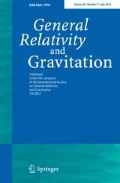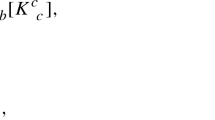Abstract
We study the internal solution, and external vacuum solution for radial cutoff, of “van Stockum dust”, an infinitely long rotating pressureless dust column; its density increases with radius. This interesting but poorly explored spacetime turns out to have a number of exotic properties, especially in the external vacuum region. These solutions have been known for decades, but it seems that they have never been investigated in detail. In this paper we analyze them and describe their peculiar properties. There are three regimes of radial cutoff that are of interest: (1) If the dust column is thick enough that closed timelike loops (CTLs or “time machines”) exist inside the column, then the radius of the entire “universe” is finite, and in fact does not extend much beyond the edge of the matter, even though the metric’s radial parameter is unbounded. This interesting finite proper radius seems to have been missed by earlier investigators. Other exotic properties of the external vacuum in this regime: CTLs exist in cylindrical shells, alternating with shells having no circular CTLs; there are infinitely many such shells, getting closer and closer together as one gets farther from the rotation axis. Also, a separate set of infinitely many cylindrical shells exists, having what might be termed “extreme frame-dragging”, within which motion is possible only in one direction; they alternate with “normal” shells allowing motion in either direction. Gravitational attraction and tides increase with distance from the matter column, and diverge at the “edge of the universe”. In addition, though the radius of the universe is finite, its circumference is infinite; and its boundary is a circle, not a cylinder (the z-axis has shrunk to nothing at the edge). (2) For smaller radial cutoff, but still large enough to produce CTLs, the radius of the universe is infinite; but there are still infinitely many cylindrical shells of CTLs alternating with non-CTL shells. However, the innermost shell begins substantially outside the dust, making this solution even stranger—you have to back away from the matter to find a CTL! And, regardless of how far away you are, there are still infinitely many CTL shells beyond you, the closest only a finite distance away. (3) For radial cutoff too close to produce CTLs, the external solution is more benign; nearby it perhaps approximates that of a finite rotating rod. But “planes” of constant z approach each other at large radii, so that any two enclose a shape somewhat like two pie-pans facing each other and glued together at their edges.


Similar content being viewed by others
References
Lánczos, K.: Über eine stationäre Kosmologie im Sinne der Einsteinschen Gravitationstheorie. Zeitschrift fur Physik 21, 73–110 (1924)
van Stockum, W.: The gravitational field of a distribution of particles rotating about an axis of symmetry. Proc. R. Soc. Edinb. 57, 135–154 (1937)
Tipler, F.: Rotating cylinders and the possibility of causality violation. Phys. Rev. 9(8), 2203–2206 (1974)
Tipler, F.: Causality violation in asymptotically flat spacetimes. Phys. Rev. Lett. 37, 879–882 (1976)
Tipler, F.: Singularities and causality violation. Ann. Phys. (N.Y.) 108, 1 (1977)
Carter, B.: Global structure of the Kerr family of gravitational fields. Phys. Rev. 174(5), 1559–1571 (1968)
Lindsay, D.: Closed timelike loops in homogeneous rotating \(\varLambda \)-dust cosmologies. Gen. Relativ. Gravit. 47, 83 (2015)
Gödel, K.: An example of a new type of cosmological solutions of Einstein’s field equations of gravitation. Rev. Mod. Phys. 21, 447–450 (1949)
Hawking, S.W., Ellis, G.: The Large Scale Structure of Space-Time. Cambridge University Press, Cambridge (1973)
Author information
Authors and Affiliations
Corresponding author
Rights and permissions
About this article
Cite this article
Lindsay, D.S. Pathologies of van Stockum dust/Tipler’s time machine. Gen Relativ Gravit 48, 121 (2016). https://doi.org/10.1007/s10714-016-2117-3
Received:
Accepted:
Published:
DOI: https://doi.org/10.1007/s10714-016-2117-3




